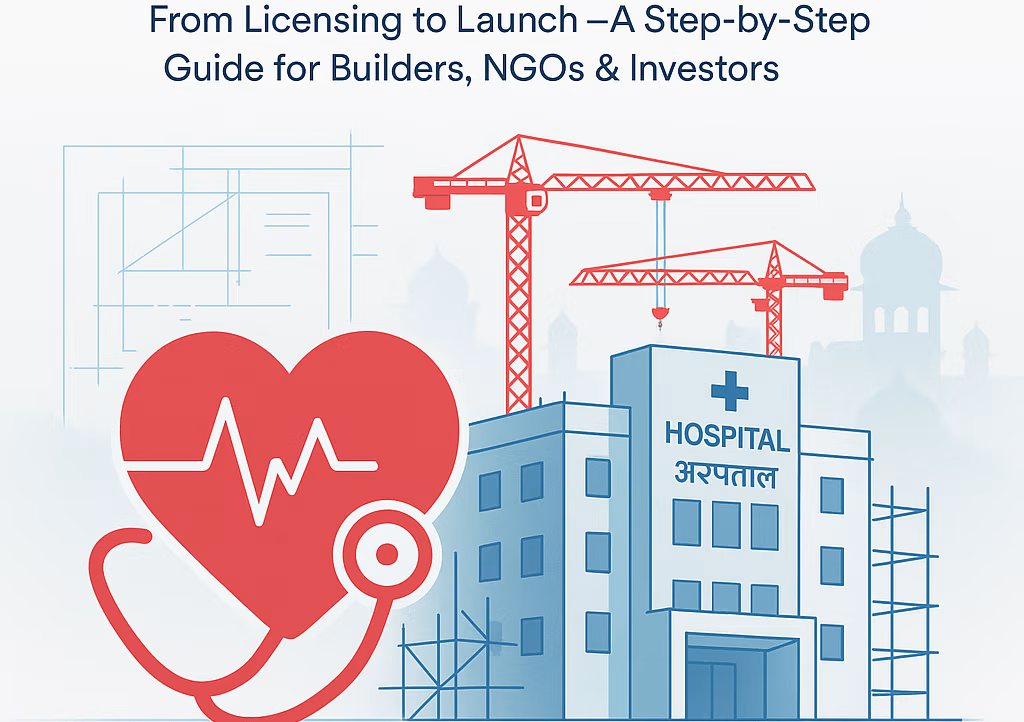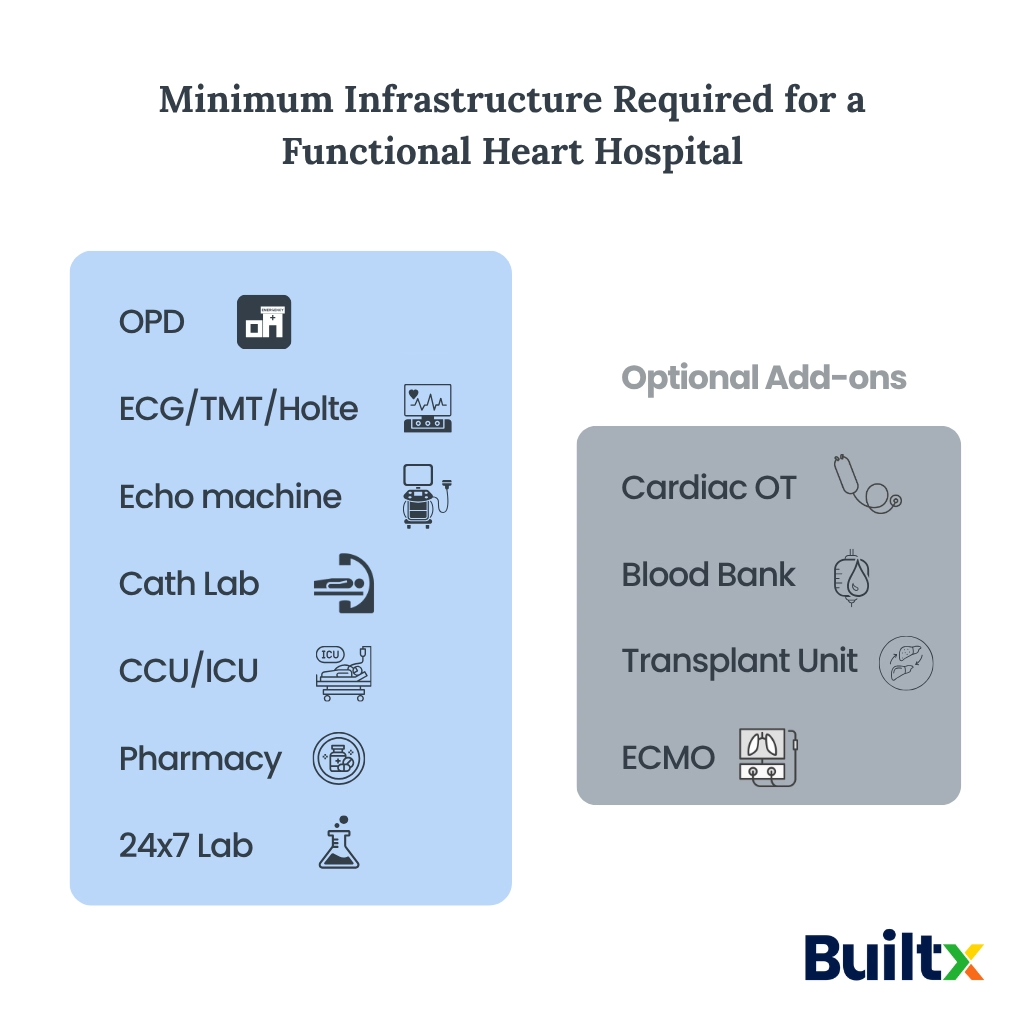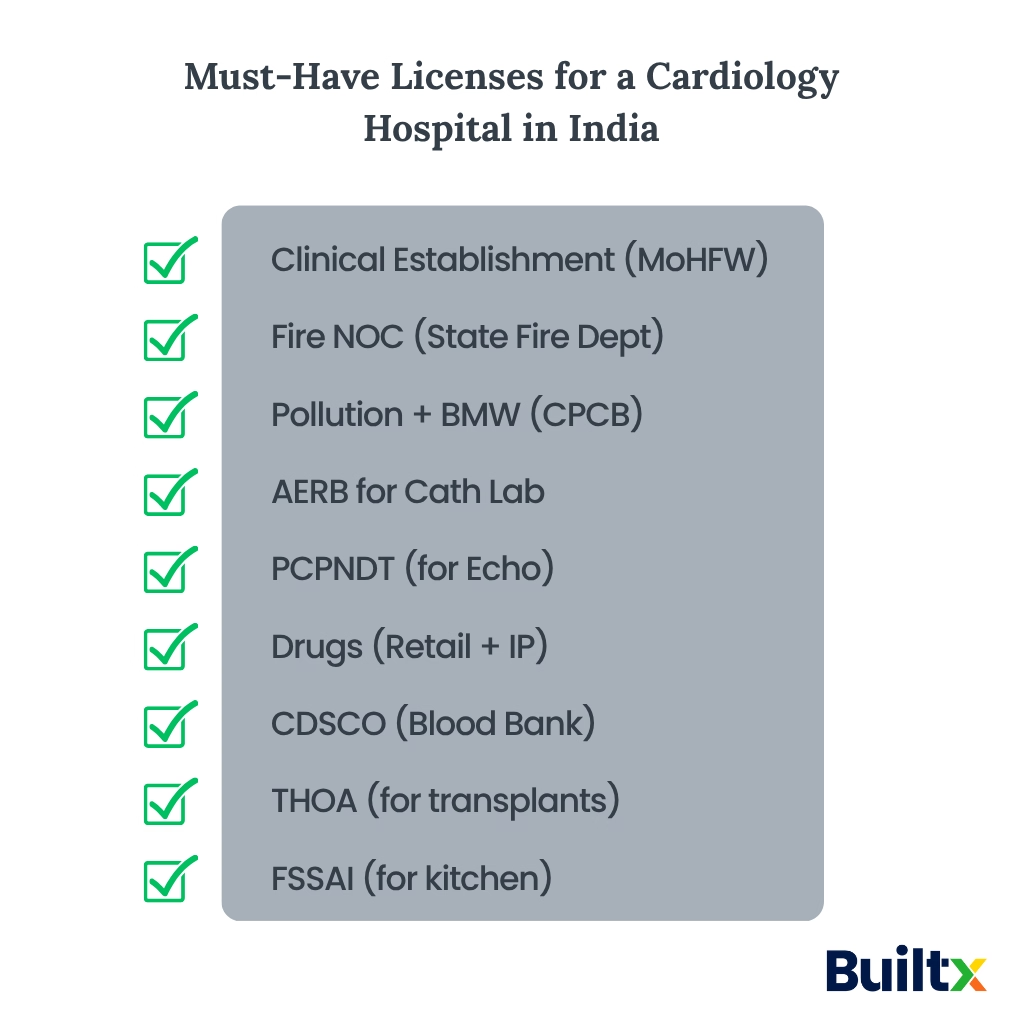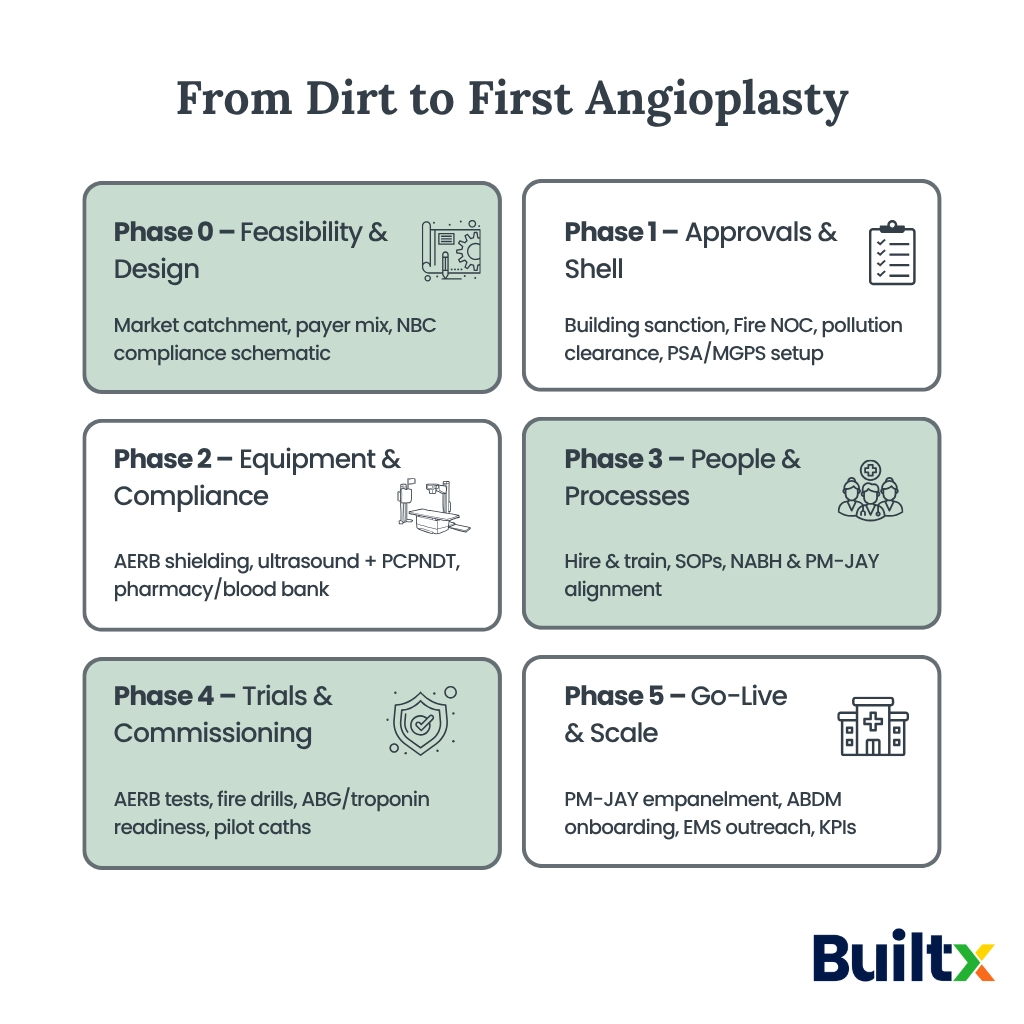Building a Heart Hospital in India (2025): A Comprehensive Guide

Table of Content
Key Takeaways
- A functional cardiology hospital needs a minimum stack: OPD, diagnostics (ECG, Echo, TMT), cath lab, CCU/ICU, and pharmacy. CT surgery, transplant, or ECMO can be added later.
- Comply with NBC 2016 (Part 4) for fire safety and the Harmonised Accessibility Guidelines for design approvals.
- Install an AERB-compliant cath lab with radiation shielding and register on eLORA.
- Get all statutory licences: CEA, Fire NOC, BMW Rules, AERB, PCPNDT, Drugs, CDSCO (Blood Bank), THOA (if transplant), FSSAI.
- Adopt NABH 6th Edition as your operational framework; begin with Entry-Level if needed.
- Empanel with PM-JAY to access government cardiology packages (e.g., PTCA ₹50,800–₹60,900 + stent).
- Integrate with ABDM: Register your hospital on HFR and doctors on HPR.
- Commission in 5 structured phases: Feasibility → Approvals → Compliance → Ops Readiness → Go-live.
India faces a growing heart health crisis. A comprehensive analysis of studies from 2000 to 2024 estimates that nearly 11% of Indian adults now live with cardiovascular disease (CVD) with significantly higher prevalence in urban and peri-urban areas.
This creates a year-round demand for cardiac diagnostics, cath labs, and critical care units, particularly in regions underserved by specialty hospitals.
At the same time, public healthcare financing is catching up. Under Ayushman Bharat PM-JAY, the government reimburses key interventional cardiology procedures such as coronary angioplasty with stenting, offering base package rates of ₹50,800–₹60,900, plus the cost of the stent.
This makes cardiac hospitals economically viable not just in metros, but also in Tier-2 and Tier-3 cities—provided infrastructure is compliant and empanelled. (PMC)

Explore the complete university accreditation roadmap
Before you begin, define your service portfolio and bed mix:
- Core Facilities: Outpatient clinics (cardiology OPD), non-invasive diagnostics (ECG, TMT, Holter, Echocardiography).
- Cath Lab (CCL): For angiography, angioplasty, stenting, and pacemaker implants.
- Critical Care: Coronary Care Unit (CCU), HDU, and ICU for cardiac emergencies.
- Optional Add-ons: Cardiac surgery OT, blood bank, ECMO, or transplant program.
- Support: 24×7 lab (troponin, ABG), pharmacy (retail + IP), radiology (X-ray/CT), CSSD, MGPS/oxygen plant.
Pro Tip: Start with a minimum viable model (40–60 beds) focusing on diagnostics and interventions. Add surgery units as demand scales.
Planning to build a hospital? Don’t miss this breakdown of licensing costs in India.
Fire & Safety (Mandatory Codes)
- Follow NBC 2016, Part 4 (Institutional Occupancy) for fire safety.
- Include fire-rated staircases, sprinklers, and smoke-stop lobbies.
- Obtain a Fire NOC before occupancy. (sehgaldoor, mptownplan.gov.in, niua.in)
Accessibility & Patient Flow
- Comply with Harmonised Guidelines for Universal Accessibility—ramps, wide corridors, patient-friendly lifts.
- Create dedicated patient routes for emergency cardiac care. (dgehs.delhi.gov.in)

Medical Gas & Power Backup
- Install Medical Gas Pipeline Systems (MGPS) and an oxygen PSA plant (mandatory post-COVID).
- Provide 100% power backup for ICUs and cath labs with UPS and dual feeders.
Cath Lab Shielding
- AERB-compliant design for radiation safety.
- Ensure lead lining in walls, radiation signage, and RSO (Radiation Safety Officer) nomination.(aerb.gov.in)
Pro tip: Sequence submissions so dependency items don’t block commissioning. Many states run single-window portals; timelines vary by state/ULB.
- Clinical Establishment Registration (state under CEA-2010 where adopted) for the hospital itself; conform to minimum standards of infrastructure, equipment, and HR. (clinicalestablishments.mohfw.gov.in)
- Fire NOC (State/UT Fire Services) based on drawings, NBC-2016 compliance, and site inspection. (mptownplan.gov.in, niua.in)
- Pollution consents & Bio-Medical Waste Authorization (Water/Air Acts + BMW Rules, 2016 with amendments). Execute a contract with a CBWTF and maintain segregation/records as per CPCB guidelines. (CPCB)
- AERB licensing (via eLORA) for:
- Cath lab (fluoroscopy/angiography)
- X-ray/CT
Includes RSO nomination, shielding report, QA/acceptance tests, & periodic compliance. (aerb.gov.in)
- Cath lab (fluoroscopy/angiography)
- PCPNDT registration (district Appropriate Authority) if any ultrasound (including echocardiography). Register the clinic and each machine; maintain Form-F and display boards. (India Code, qps.nhsrcindia.org)
- Pharmacy/Drugs licences (state FDA) for retail & IP stores under Drugs & Cosmetics Act.
- Blood Bank (if planned): CDSCO/State Drug Controller licence with NABH/NABL quality systems. (Surgeries/CTVS programs typically require it.)
- Transplant (optional): THOA-1994 registration for any organ retrieval/transplant activity (e.g., heart transplant) via the State Appropriate Authority.
- FSSAI licence (kitchen/cafeteria) and lift/electrical/boiler approvals as applicable.

Hospital Licenses and Permits Guide 2025
- NABH (6th Edition, effective 2025): Use it as the backbone for SOPs, infection control, medication safety, patient rights, clinical audits, and sentinel events. Smaller centres can start with Entry-Level (SHCO/HCO) and graduate to full accreditation. (portal.nabh.co, nabh.co)
- PM-JAY empanelment: Follow NHA’s 2022 Empanelment Guidelines; ensure specialty, bed, ICU, and equipment criteria match declared packages (e.g., cardiology with cath lab for interventional packages). (National Housing Authority)
- ABDM integration: Register your facility on the Health Facility Registry (HFR) and clinicians on HPR to enable digital health records and interoperable patient journeys. (India Code, cdsco.gov.in)
- Package economics: For planning, benchmark PM-JAY HBP cardiology rates (e.g., PTCA base rate range noted above) and map your private/TPA tariffs accordingly.
NABH Accreditation Process 2025
- Throughput trumps everything: Cath lab utilization, case mix (diagnostic vs PCI), and 24×7 STEMI pathway volumes drive margins more than list prices.
- Balanced payer portfolio: PM-JAY (public), CGHS/ESIC/TPAs (organised), self-pay (local). Use PM-JAY package rates as your floor; design implant procurement (stents/devices) and LOS to keep contribution positive.
- Capex discipline: Shell & MEP that meet NBC/Fire + MGPS/PSA; cath lab, ICU/CCU monitoring, ultrasound, IABP; IT stack for ABDM/NABH. (Avoid vendor lock-in on disposables; insist on multi-brand compatibility.)
- Quality = reimbursement: NABH and PM-JAY compliance reduces denials, speeds cashflow, and unlocks packages and PPP opportunities. (National Housing Authority)
- Doctors: Interventional cardiologists, anesthetists, intensivists.
- Nursing: ACLS-trained CCU nurses and cath lab technicians.
- Support Staff: Biomedical engineers, infection control officer, and quality manager.
- Golden Rule: A 60-bed heart hospital requires at least 2–3 cardiologists and a 24×7 emergency team.
7 Benefits of Sustainable Architecture that Every Nonprofit Should Know
- ABDM (Ayushman Bharat Digital Mission): Register your hospital on HFR (Health Facility Registry).
- PM-JAY Empanelment: Enables government insurance coverage for cardiac procedures.
- Hospital Information System (HIS): For patient records, billing, and integration with TPAs.
See how to build a patient centric hospital in 2025
- Conduct trial runs and mock drills (fire, code blue).
- Launch awareness campaigns on preventive heart care.
- Partner with ambulance networks and local clinics for STEMI pathway referrals.

The demand for high-quality cardiology hospitals in India is growing faster than ever, especially in underserved Tier 2 and Tier 3 cities. Whether you're a healthcare investor, a non-profit, or a private healthcare provider, setting up a NABH-compliant, AERB-licensed heart hospital is a high-impact, financially viable step toward transforming cardiac care in India.
To succeed, your hospital must:
- Align with NBC 2016 fire and safety codes
- Secure all mandatory licences—CEA, Fire NOC, AERB, PCPNDT, BMW
- Offer core cardiac services: cath lab, CCU/ICU, non-invasive diagnostics
- Integrate with PM-JAY and ABDM digital health records
- Follow the NABH 6th Edition quality standards
Need an expert construction partner for your heart hospital project?
BuiltX is India’s only construction firm that exclusively partners with NGOs, trusts, and mission-driven institutions to build fully compliant, optimized, on time and within budget. We have experience in building impactful infrastructure, Whether you are based in Bihar, Delhi or anywhere in India. Book a free consultation with BuiltX
Q1. Do we need AERB approval for a cath lab?
A1. Yes. Cath labs use fluoroscopy (X-ray). You must obtain AERB consent via eLORA, with shielding design, RSO nomination, acceptance tests, and periodic audits. (aerb.gov.in)
Q2. Does echocardiography need PCPNDT registration?
A2. Yes. Any facility operating an ultrasound machine (including echo) must register under the PCPNDT Act with the district authority and maintain statutory records. (India Code)
Q3. What are India’s core fire-safety rules for hospitals?
A3. Follow NBC-2016 Part 4 (Institutional occupancy) for compartmentation, exits, smoke control, sprinklers/hydrants, alarms and trained personnel. Fire NOC is issued upon compliance and inspection. (mptownplan.gov.in)
Q4. Is NABH mandatory?
A4. Not by law, but strongly recommended. The NABH 6th Edition (2025) is the de-facto framework for quality & safety and helps with empanelment and payer negotiations. (portal.nabh.co)
Q5. What PM-JAY cardiology package should we model?
A5. Use the HBP list; e.g., “Coronary angioplasty with stent (including angiogram)” base rate ₹50,800–₹60,900 plus stent cost. Validate state add-ons.

